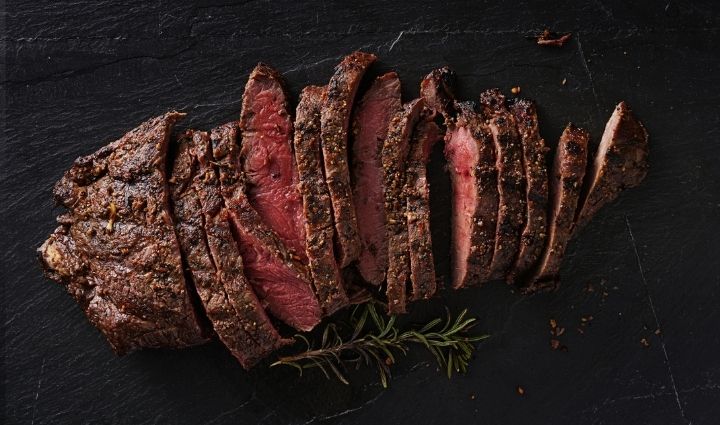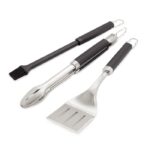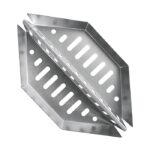Nothing solidifies your grill god status like serving up steak with a perfectly seared crust and a juicy, tender middle.
Grilling steak can be intimidating, especially if you’ve tried it before and the result was less than desirable or you’re cooking for a crowd. Getting that delicious crust and juicy interior can be a tough balancing act, but with some easy prep and the right grilling method, great grilled steak is nothing to sweat over.
Keep reading to learn how to prepare steak for grilling, how to cook the perfect steak on a gas grill, reverse searing steak on a gas grill, and how to grill steak on a charcoal grill.
How To Prepare Steak for Grilling
Preparing steak for grilling is easy and only takes a few minutes. Follow these steps:
- Season the meat. For thick steaks, season each side of the steak with ½ teaspoon kosher salt or ¼ teaspoon table salt per pound of steak, then refrigerate it for 1-2 hours. The salt acts as a brine to help tenderize the meat and keep it juicy while it cooks. You can also use a spice rub, but a high-quality cut of steak has enough flavor on its own and often doesn’t need a spice rub. For thin steaks, you can use a marinade instead.
GRILL SPOT TIP: Include some sugar in the marinade—sugar helps tenderize tougher cuts.
- Remove the steaks from the fridge about 30 minutes before you plan to grill. This gives them time to lose the chill from the fridge, which helps you get a better sear and ensures your steak will cook evenly.
- Pat each steak dry with a paper towel for the best browning and flavor—dry steaks will sear more effectively. Re-season with salt and freshly ground pepper and your steaks are ready to grill.
How To Grill Steak on a Gas Grill
There are two ways to grill steak on a gas grill: direct grilling and the reverse sear method.
Whichever method you opt for, start by preparing a two-zone grill. You’ll use the intense, direct heat side to sear the steak and create a crust, and the lower heat, indirect zone to cook your steak through the center. Learn how to set up a gas or charcoal barbecue for two-zone grilling in our guide to direct vs. indirect grilling methods.
Direct Grilling Steak on a Gas Grill
Direct grilling is the most traditional way to grill steak on a gas grill. Follow these steps:
- Heat your grill to high, then clean and grease the cooking grates. Reduce the heat on one side of the grill to create two cooking zones.
- For thin steaks (less than 1 ½ inch thick), grill steak over direct heat till it reaches your desired level of doneness, then remove and let the steaks rest for at least 5
minutes before slicing or serving. - For thicker cuts of steak, start by searing the seasoned steaks over direct heat. Place steaks over direct heat for about 3 minutes, rotating partway through to create cross-hatched grill marks. Flip the steaks when you see juices rise to the surface. Sear for another 3 minutes, rotating part way through again.
- Once you have a good crust, slide the steaks over to the indirect heat zone. Close the lid and cook until they reach the desired level of doneness. Use the thumb test or a meat thermometer to judge doneness.
- Remove the steaks from the grill and let them rest for at least 5 minutes before slicing or serving.
Reverse Searing Steak on a Gas Grill
For thicker cuts of steak, many grillers are now opting for the popular reverse sear method. Here’s how to reverse sear steak on a gas grill:
- Heat your grill to high, then clean and grease the cooking grates. Reduce the heat on one side of the grill to create two cooking zones. Aim for a temperature of 225 degrees on the indirect side. Make sure you have a functioning grill thermometer to ensure you’ve hit the right temperature, or for even more precision, use a smart thermometer with an ambient temperature probe.
- Place the steaks over indirect heat and close the lid. After about 15 minutes, start checking the temperature of the meat, flipping the steaks halfway through cooking. You want it to be about 10-15 degrees below your desired temperature to leave room for the extra cooking that will occur when searing and resting. Most experts recommend removing steaks when they reach 110 degrees.
- When the steaks hit your target temperature, remove them from the grill and crank up the heat. Close the lid and turn all burners to high for a few minutes.
- Place the steaks back on the grill. Sear on one side for 1-2 minutes, rotating part way through for cross-hatched grill marks. Flip the steaks and sear for 1-2 more minutes, rotating part way through again.
- Take the steaks off the grill and let them rest for at least 5 minutes before slicing and serving.
GRILL SPOT TIP: No matter which cooking method you choose, you can check your steak for doneness using the thumb test. Meat thermometers are more precise, but can let juices escape when you puncture the crust.
How To Grill Steak on a Charcoal Grill
To cook steak on a charcoal grill, you’ll follow the same initial steps as cooking a steak on a gas grill.
If you’re reverse searing steak on a charcoal grill, instead of cranking up the heat for the final sear, gather the lit coals into a pile or add half a chimney’s worth of fresh lit coals to concentrate the heat.
If you’re looking for a unique way to grill a steak on a charcoal BBQ, try the caveman or fire steak method. This method involves cooking steak directly on hot coals and is best for thick steak cuts. Here’s how to grill a steak caveman-style:
- Start a fire using lump charcoal and heat your grill to medium-high heat. When the coals are lit, scatter them into a single layer.
GRILL SPOT TIP: Lump charcoal is less likely to leave ash on your steaks than briquettes. Briquettes can also impart an undesirable chemical flavor.
- Season the steaks. Brush them lightly with a coat of olive oil, then sprinkle on generous amounts of salt and freshly ground pepper. Some grillers recommend only seasoning with salt because the peppercorns can burn, but others say go for both—the toasted peppercorns can add an extra hint of tasty charred flavor.
- Fan off any excess ash from the surface of the coals using a newspaper, cardboard, or anything you have laying around. If some ash ends up on your steak, don’t panic—small amounts won’t hurt you, but you can brush it off if you prefer.
- Place the steaks directly on the hot coals and cook for 3-4 minutes. Midway through, turn the steaks 90 degrees to make sure all parts come into contact with the coals and you get a good sear all over.
- When juice starts bubbling out of the top of the steak, remove it from the grill and rearrange the coals so fresh hot coals are facing up. Flip the steak and put it back on the grill, turning it 90 degrees again part way through.
- Test for doneness using an instant-read thermometer. In this case, reaching your hand into the flames to do the thumb test is not advised.
- Remove the steaks and let them rest for 5-10 minutes, then slice and serve.
6 Tips for Cooking Steak on the Grill
Grill up the perfect steak with these tips:
- Cut matters, but most cuts are good for grilling. Thicker, more expensive cuts like ribeye, strip steak, and T-bone offers maximum juiciness, while thinner, tougher cuts like flank, hanger, and skirt steaks are more affordable and are rich in flavor. Tougher cuts also stand up well to marinating.
- Don’t be afraid of salt. Some grillers say that salting your steaks too much or too early draws moisture out of the steak. While it’s true that salt will draw out moisture, when the steak hits the cooking grate, the sugars and proteins in the moisture will combine with the salt to create a delicious crust. Any moisture loss is more than made up for by that perfect crusty sear.
- Don’t skip the warming phase. If the steak is too cold when it hits the grill, the interior will require more cooking time to reach doneness and the exterior might overcook.
- You can flip your steak more than once. Flipping it at least twice actually results in more even cooking. Just make sure you don’t flip it before it’s had a chance to develop that gorgeous crust.
- Don’t walk away! Grilling steak is a high “steaks” game. Taking your steak off the grill even one minute late is enough to push it from medium-rare to medium, or even well done if your heat is high enough.
- Resting is critical—do not skip the 5-10 minute resting phase! Resting cooked steak allows the juices to redistribute inside the steak, and also gives it a chance to finish cooking—the internal temperature of your steak will increase about 5 degrees while it rests.
Perfectly Grilled Steak Every Time
By preparing your steaks properly and using the right grilling method—and the right tools and a few useful tricks—you can grill steak perfectly every time. Check out these resources to set yourself up for success:





